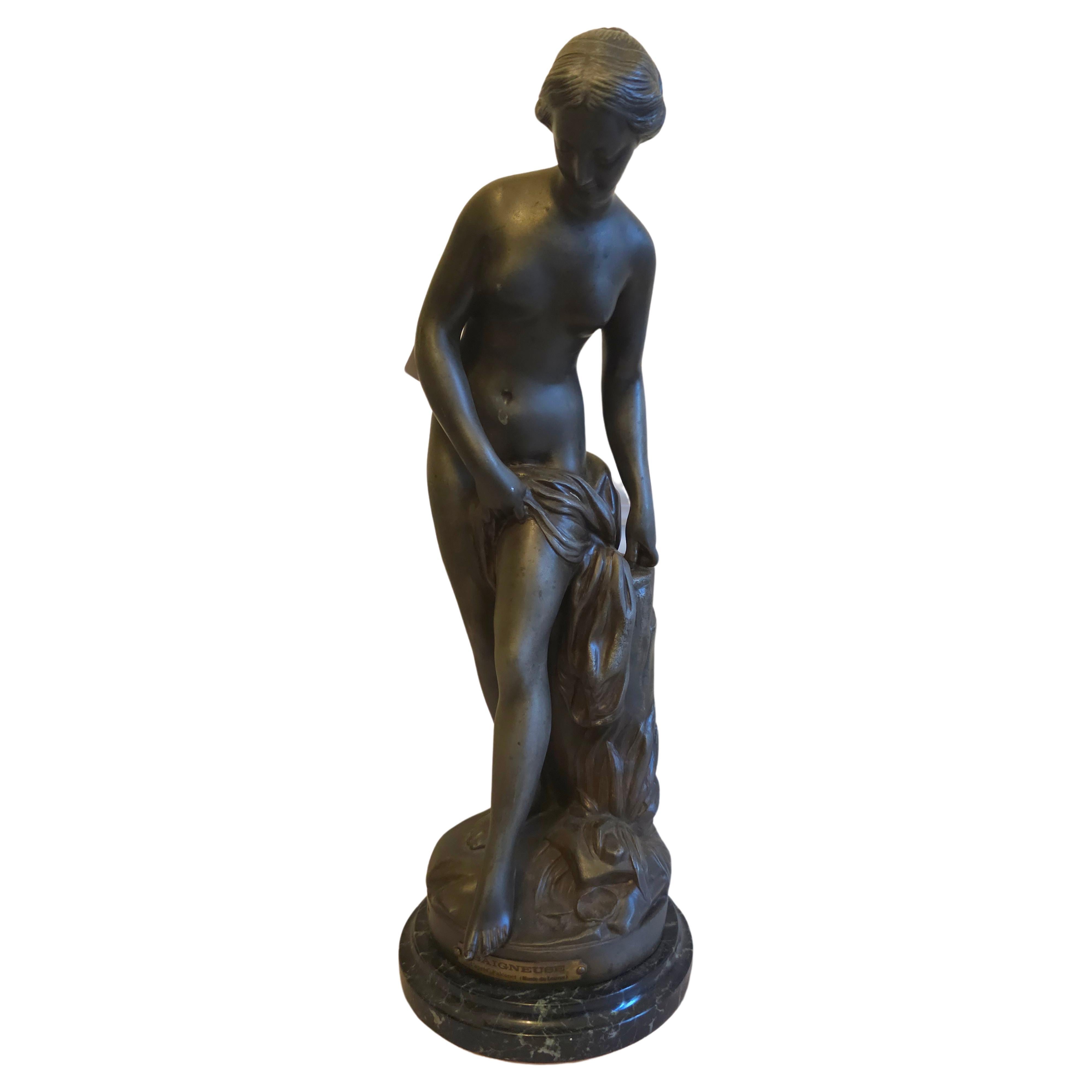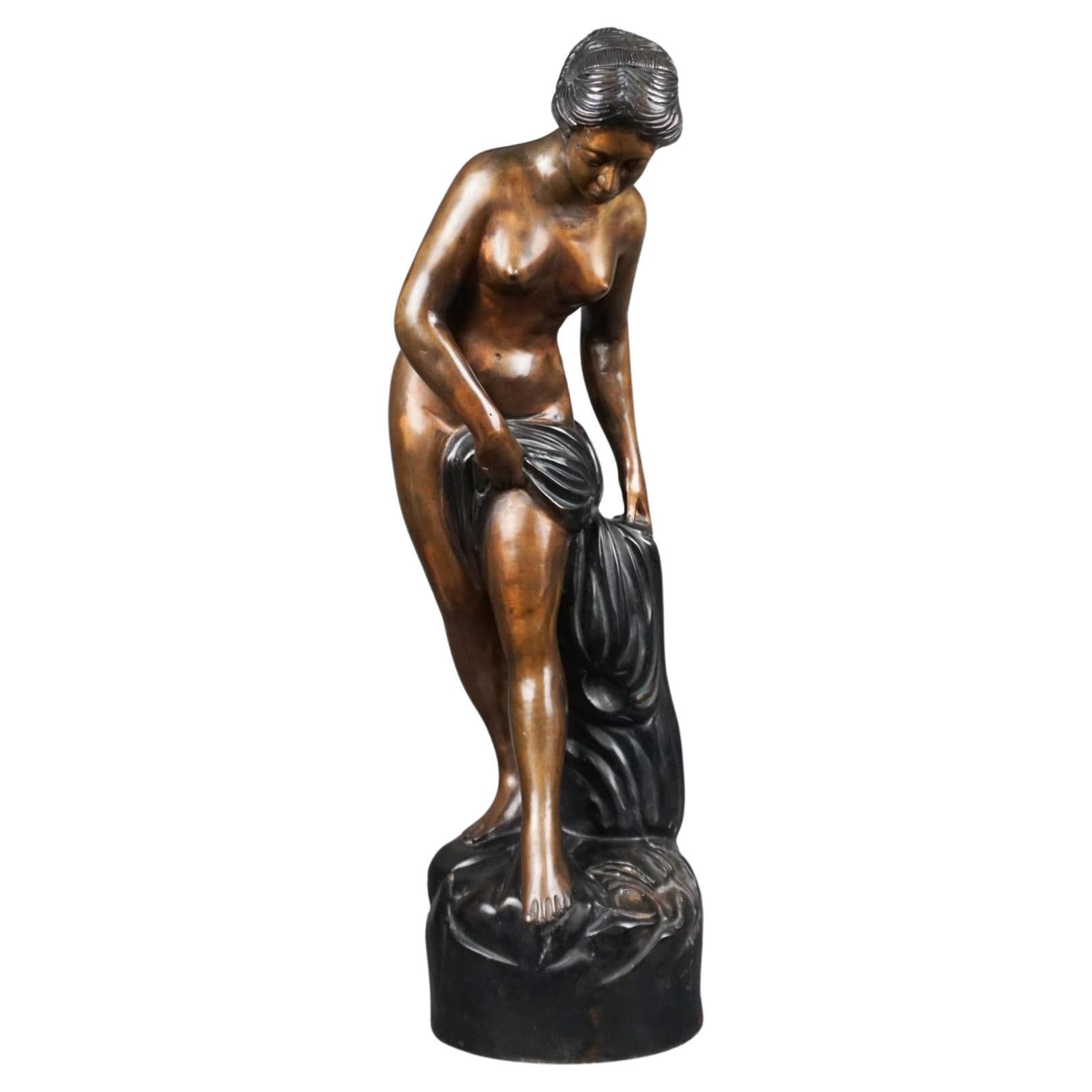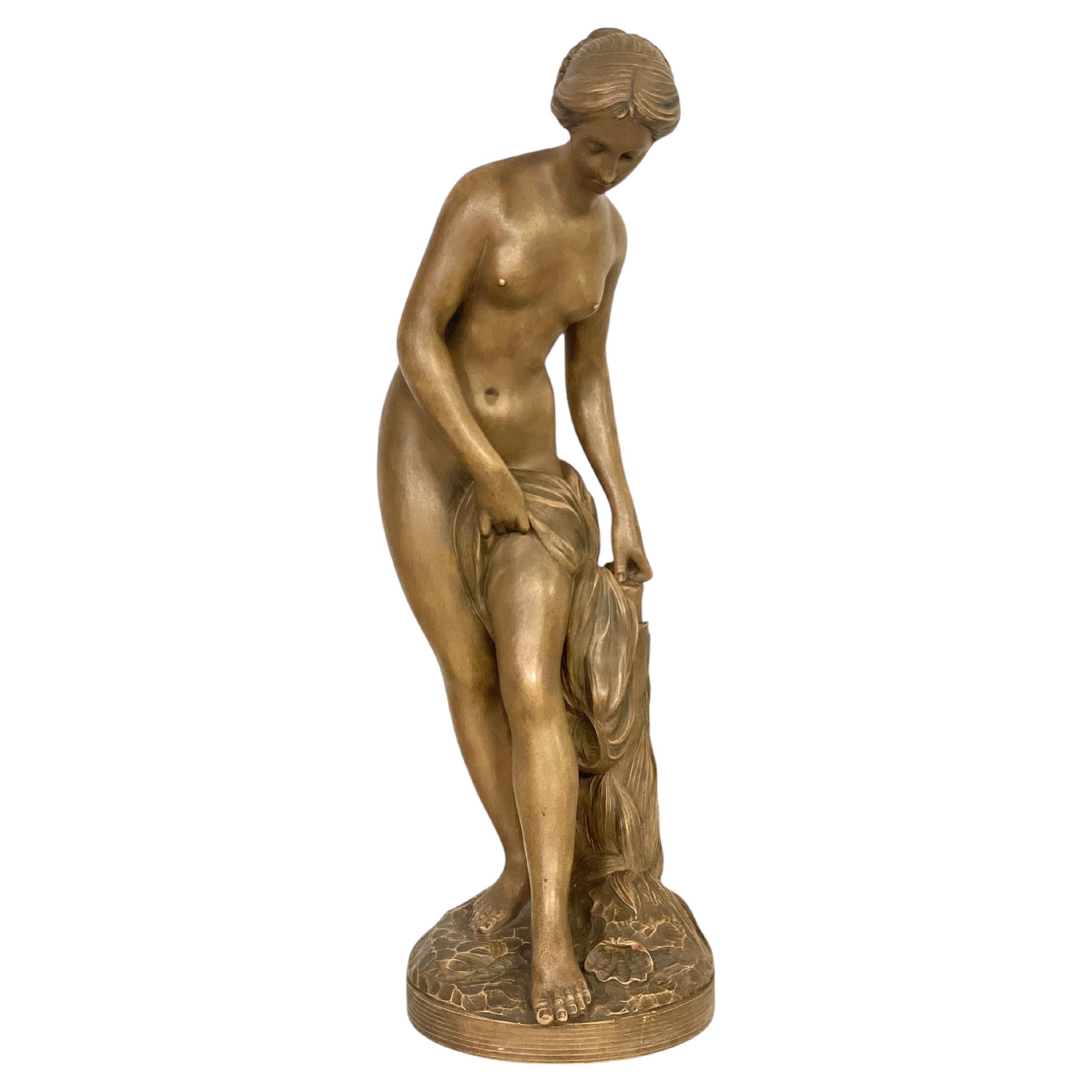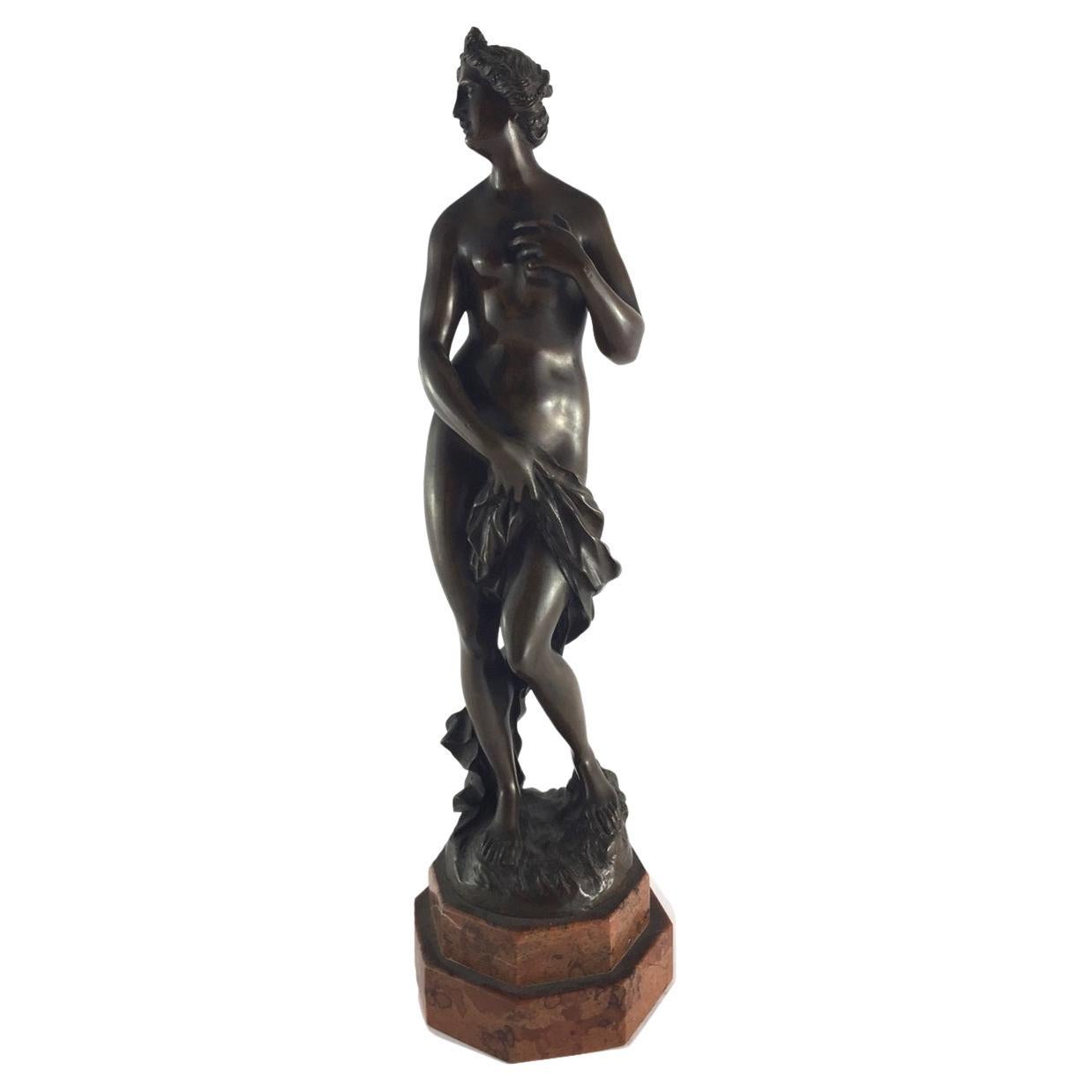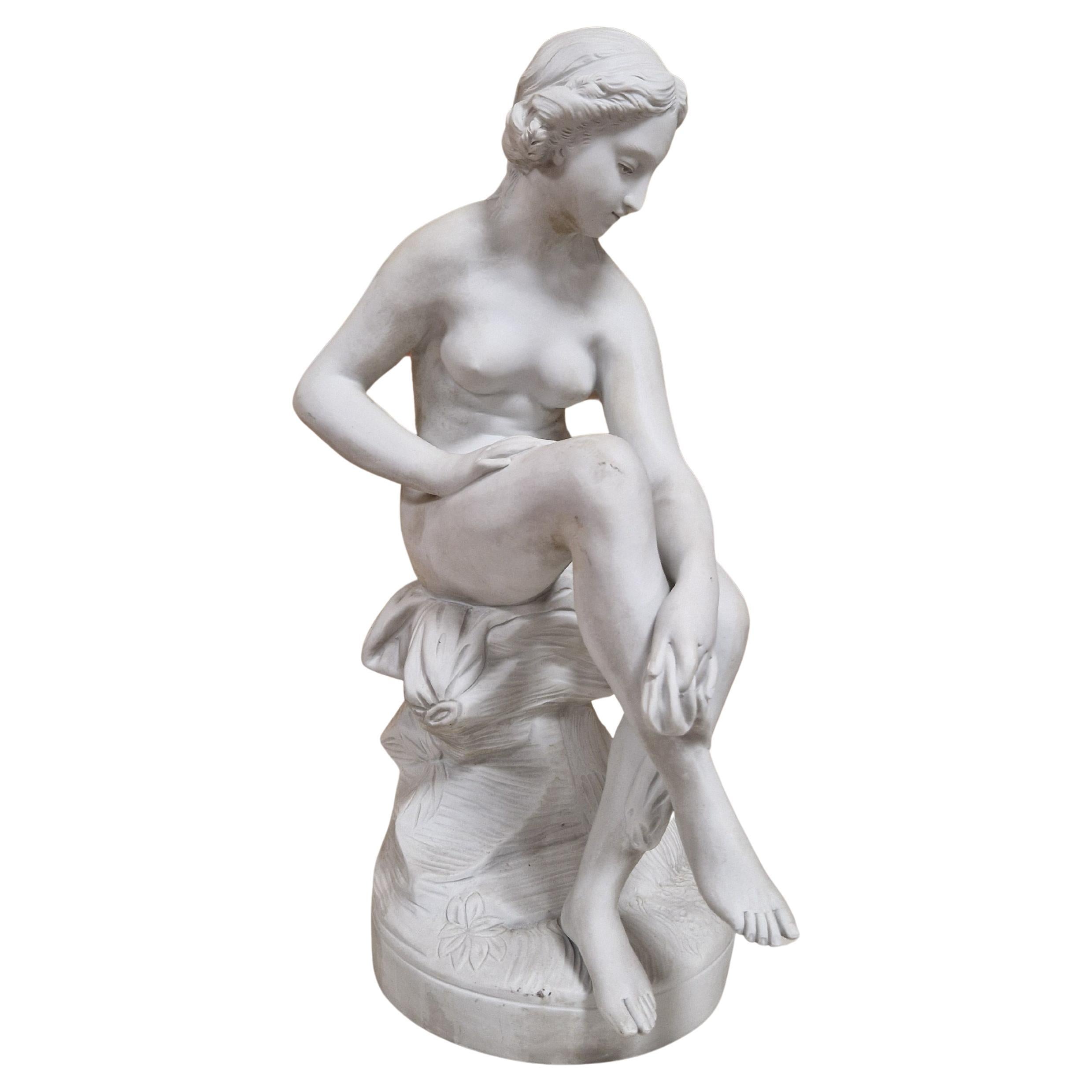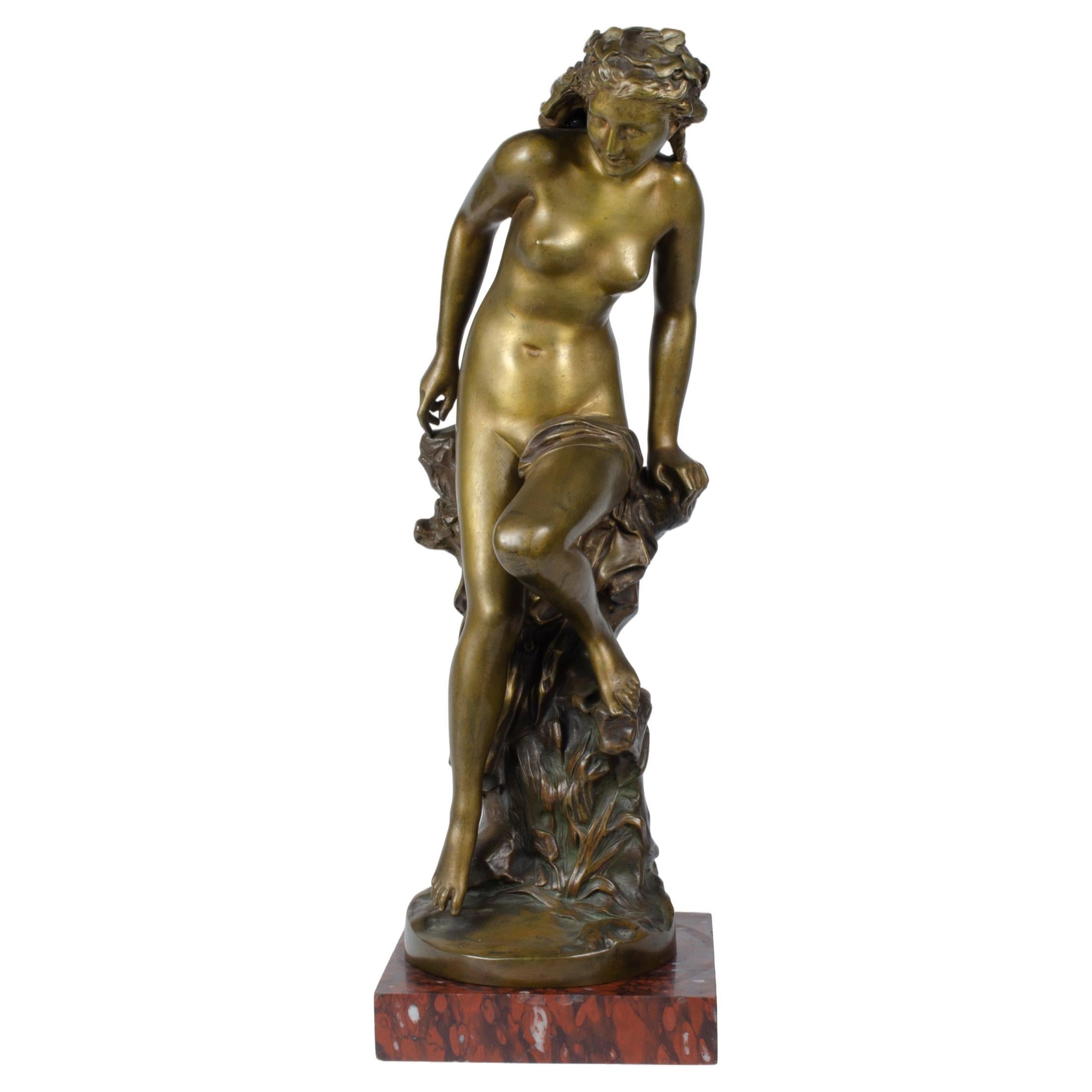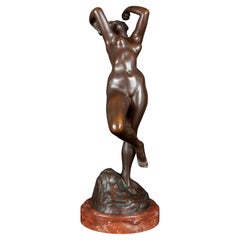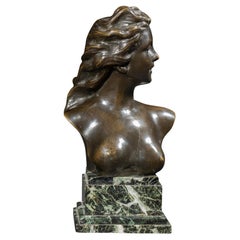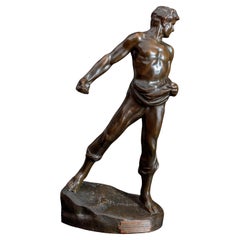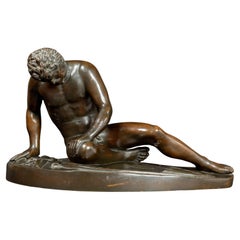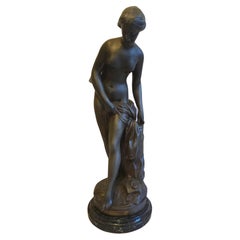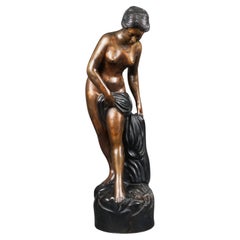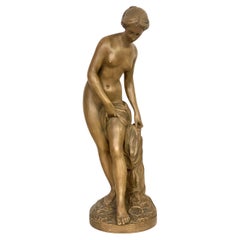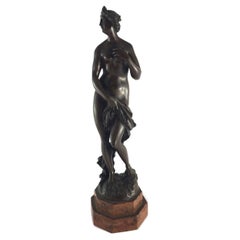Items Similar to « La Baigneuse » ou « La Nymphe prenant son bain » (1757)
Want more images or videos?
Request additional images or videos from the seller
1 of 12
« La Baigneuse » ou « La Nymphe prenant son bain » (1757)
$17,783.94
£13,309.36
€15,000
CA$24,534.49
A$27,283.37
CHF 14,329.82
MX$333,566.54
NOK 178,563.23
SEK 168,336.90
DKK 114,187.45
About the Item
Étienne-Maurice Falconet (1716-1791), "The Bather" or "The Nymph Bathing" (1757)
Artistic Explanation:
The Nymph Bathing is a masterpiece of 18th-century French sculpture, created by Étienne-Maurice Falconet in 1757. This bronze statue depicts a nude young woman in a graceful and natural pose, captured in an intimate moment as she enters her bath.
Pose and Expression:
The nymph is depicted in a fluid, natural pose, leaning slightly forward as if gathering or setting down a cloth. This posture highlights the elegant curves and anatomical details of the female form, celebrating natural beauty and grace.
Details and Textures:
The texture of the drapery and the subtle details of the hair and skin are beautifully rendered, demonstrating Falconet's mastery of bronzework. The interplay of light on the polished bronze surface adds a vibrant and realistic dimension to the sculpture.
Symbolism:
The choice to depict a nymph, a mythological figure often associated with nature and water, reflects the influence of classical and mythological themes in 18th-century art. It attests to the period's interest in antiquity and the ideals of classical beauty.
Historical Context:
- Period: The sculpture was created in 1757, a period when the Rococo style was flourishing in France. This style is characterized by its elegance, refinement, and a penchant for graceful and delicate subjects.
- Style: While Falconet is often associated with the Rococo style, this work shows a transition towards a more Neoclassical style, with a simplicity and purity of form that foreshadows future artistic trends.
- Patronage: The work was commissioned by the financier and collector Ange Laurent Lalive de Jully, demonstrating the interest of the elite at the time in classical art and culture.
The Bronze Caster:
The exceptional quality of the casting of this sculpture is the result of the work of a skilled bronze caster. At that time, casters often worked closely with sculptors to create high-quality pieces. Renowned casters of this period included workshops such as Jean-Baptiste Claude Odiot or the Keller brothers, although specific documentation on the caster of this work is not always available.
Museum Collections:
Examples of The Nymph Bathing can be found in several prestigious museums, including:
• The Louvre Museum in Paris, which has a rich collection of 18th-century French sculptures.
• The Museum of Fine Arts in Lyon, where one can also admire other works by Falconet and his contemporaries.
• The Hermitage Museum in Saint Petersburg.
Symbolism of the Work:
The Nymph Bathing symbolizes both ideals of beauty and purity, the intimate relationship between humans and nature, and the stylistic transitions in 18th-century art. It embodies the decorative and elegant elements of the Rococo while anticipating the simplicity and grandeur of Neoclassicism. The nymph represents the ideal of female beauty in the classical tradition, purity, innocence, and a connection to nature and mythological elements.
Link to the Daughter of Madame de Pompadour:
It is interesting to note that Falconet was supported by Madame de Pompadour, the mistress of Louis XV and a great patron of the arts. The daughter of Madame de Pompadour, Alexandrine Le Normant d'Étiolles, died young, and Falconet may have found some inspiration in the youth and beauty of this child, as well as in the influence of her mother, to create works imbued with grace and tenderness.
Biography of Étienne-Maurice Falconet:
Étienne-Maurice Falconet (1716-1791) was a French sculptor renowned for his refined and elegant works. He was trained at the Royal Academy of Painting and Sculpture and worked under the direction of the famous sculptor Jean-Baptiste Lemoyne. Falconet quickly gained recognition for his graceful sculptures and portraits.
Career: In 1757, Falconet was appointed director of the sculpture workshop at the Manufacture de Sèvres, where he influenced many young artists. In 1766, he was invited by Catherine II of Russia to work at the imperial court in Saint Petersburg, where he created his most famous work, The Bronze Horseman, a monumental equestrian statue of Peter the Great.
Style and Influence: Falconet was a pioneer in the transition from Rococo to Neoclassicism, combining decorative elegance and classical simplicity. His work has had a lasting influence on European sculpture.
In summary, The Nymph Bathing is an emblematic work that perfectly illustrates the talent and artistic vision of Falconet, while reflecting the tastes and artistic trends of his time.
- Creator:Étienne Maurice Falconet (Sculptor)
- Dimensions:Height: 19.3 in (49 cm)Width: 7.09 in (18 cm)Depth: 6.7 in (17 cm)
- Style:Baroque (Of the Period)
- Materials and Techniques:
- Place of Origin:
- Period:1750-1759
- Date of Manufacture:1757
- Condition:Wear consistent with age and use.
- Seller Location:Ixelles, BE
- Reference Number:1stDibs: LU10116242275272
About the Seller
No Reviews Yet
Vetted Professional Seller
Every seller passes strict standards for authenticity and reliability
1stDibs seller since 2024
- ShippingRetrieving quote...Shipping from: Ixelles, Belgium
- Return Policy
Authenticity Guarantee
In the unlikely event there’s an issue with an item’s authenticity, contact us within 1 year for a full refund. DetailsMoney-Back Guarantee
If your item is not as described, is damaged in transit, or does not arrive, contact us within 7 days for a full refund. Details24-Hour Cancellation
You have a 24-hour grace period in which to reconsider your purchase, with no questions asked.Vetted Professional Sellers
Our world-class sellers must adhere to strict standards for service and quality, maintaining the integrity of our listings.Price-Match Guarantee
If you find that a seller listed the same item for a lower price elsewhere, we’ll match it.Trusted Global Delivery
Our best-in-class carrier network provides specialized shipping options worldwide, including custom delivery.More From This Seller
View AllJEF LAMBEAUX (1852 – 1908) Bronze Statue "THE DANCER WITH CASTANETS"
By Jef Lambeaux
Located in Ixelles, BE
JEF LAMBEAUX (1852 – 1908) Bronze Statue "THE DANCER WITH CASTANETS" .
Imagine a sculpture that transcends mere representation to capture the very essence of movement and passion. "...
Category
Antique 19th Century Belgian Art Nouveau Figurative Sculptures
Materials
Bronze
JEF LAMBEAUX (1852-1908) "Bust of a Young Woman" in bronze
By Jef Lambeaux
Located in Ixelles, BE
JEF LAMBEAUX (1852-1908) "Bust of a Young Woman" in bronze.
Jef Lambeaux's "Bust of a Young Woman" with bared breasts is a striking work of art that embodies both beauty and controversy. Created by the eminent Belgian sculptor Jef Lambeaux (1852-1908), this bronze sculpture reveals exceptional technical mastery and extraordinary artistic sensitivity. The young woman depicted, with her hair flowing freely and her face imbued with serenity, embodies the quintessence of feminine beauty.
This work is part of the Romantic Realism...
Category
Antique Late 19th Century Belgian Art Nouveau Busts
Materials
Bronze
Jef Lambeaux (1852-1908) “THE SOWER”
By Jef Lambeaux
Located in Ixelles, BE
Jef Lambeaux (1852-1908) “THE SOWER”
Artistic Description:
"The Sower" depicts a vigorous young man, bare-chested, in the act of sowing seeds. The sculpture captures with precision...
Category
Antique Late 19th Century Belgian Art Nouveau Figurative Sculptures
Materials
Bronze
"The Dying Gaul": Bronze sculpture 'Gala Morente' cast by CHIURAZZI NAPOLI
Located in Ixelles, BE
The Dying Gaul.
- Description of the Work:
A Celtic warrior lies nude, half-reclining on his shield, his body contorted by pain. His right hand touches the ground while his face, m...
Category
Antique 19th Century Hellenistic Figurative Sculptures
Materials
Bronze
Louis-Ernest Barrias (1841-1905) Bronze Bas-Relief "The Reader"
By Louis Ernest Barrias, Susse Freres
Located in Ixelles, BE
Louis-Ernest Barrias (1841-1905) Bronze Bas-Relief "The Reader".
Bas-Relief: "The Reader" is a bas-relief created by Louis-Ernest Barrias, a renowned 19th-century sculptor. The bas-...
Category
Antique 19th Century French Neoclassical Figurative Sculptures
Materials
Bronze
Attributed to GUSTAVE LOUIS BUCHET (1888-1963) Bronze statue "L'EFFORT"
By Gustave Buchet
Located in Ixelles, BE
Attributed to GUSTAVE LOUIS BUCHET (1888-1963) Bronze statue "L'EFFORT" or "L'ATHLETE".
Description of the work The statue "L'EFFORT" or "THE MAN LIFTING A STONE" Attributed to Gust...
Category
20th Century Swiss Art Deco Figurative Sculptures
Materials
Bronze
You May Also Like
Etienne Falconet 1716-1796 La Baigneuse (The Bather) Diana at Well Sculpture
By Étienne Maurice Falconet
Located in Germantown, MD
After Etienne-Maurice Falconet (French 1716 - 1791) La Baigneuse (Bathing Woman, The Bather) Patinated Spelter sculpture of Diana at the well. Signed and dated 1765
Measures 6" in w...
Category
20th Century French Beaux Arts Figurative Sculptures
Materials
Marble, Spelter
Etienne Falconet 1716-1796 La Baigneuse (The Bather) Diana Sculpture
By Étienne Maurice Falconet
Located in Germantown, MD
After Etienne-Maurice Falconet (French 1716 - 1791) La Baigneuse (Bathing Woman)
Large 29" tall sculpture of Diana at the well.
Measures 8.5" in width, 8.5" in depth and stands 29" ...
Category
20th Century French Beaux Arts Figurative Sculptures
Materials
Bronze, Copper
Terracotta Sculpture « La Baigneuse » After Falconet 19th Century
By Étienne Maurice Falconet
Located in LA CIOTAT, FR
This elegant terracotta sculpture is a refined interpretation of a classical female nude, inspired by the celebrated 18th-century French sculptor Étienne-Maurice Falconet. The piece ...
Category
Antique 19th Century French Figurative Sculptures
Materials
Terracotta
19th Century Bronze Scuplture "Venus Bather" by H.S. München
By H.S. Munchen
Located in Firenze, FI
Lost wax cast Italian bronze sculpture, the subject reproduces 'Venus bather'. The base is made of Bardiglio red marble. Italian manufacture, early 19th century. Made by H.S. München...
Category
Antique Early 19th Century Italian Empire Figurative Sculptures
Materials
Bronze
Antique Sculpture of Diane Bathing After Falconet
Located in Buxton, GB
This exquisite sculpture depicts the goddess Diane bathing in all her beauty, crafted after the famous Falconet statue. The piece is made of high-quality biscuit material and boasts ...
Category
Antique 19th Century French Neoclassical Figurative Sculptures
Materials
Porcelain
Sculpture “La Frileuse” by Jean-Baptiste Carpeaux
By Jean-Baptiste Carpeaux
Located in Ciudad Autónoma Buenos Aires, C
Sculpture “La Frileuse” by Jean-Baptiste Carpeaux (1827-1875). It is made of gilded bronze supported on a red marble base. Signed JB Carpeaux, P B, Susse Frères, Editeuns Paris, Suss...
Category
Antique 1860s French Art Nouveau Figurative Sculptures
Materials
Marble, Bronze
More Ways To Browse
La Period Furniture
Forward Trend
Portrait Of Louis Xv
Madame De Pompadour
Nymph Statue
Female Nude Statue
Mother And Child Statue
Mother Child Statue
Russian Paintings Of Saints
Sevres Imperial
Horseman Sculpture
Russian Statue
Bronze Nude Nymph
Etienne Maurice Falconet
Sevres Statue
Sevres 1750
Bather Statue
The Bather Falconet
